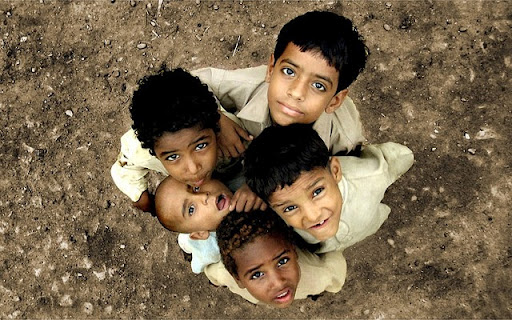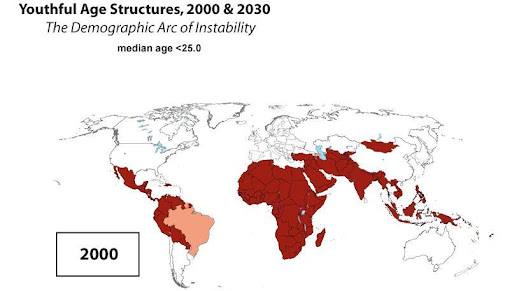-
Whither the Demographic Arc of Instability?
December 14, 2010 By Richard Cincotta
After the Berlin Wall came down in 1989, the demand for geostrategic mapping went up. Pentagon geographers revised maps almost monthly in order to keep pace with the rapid sequence of events – the toppling of Eastern Europe’s communist regimes, the rise of pro-Western liberal democracies in their place, and the reunification of Germany. Then came more borders, and even more maps: the breakup of the Soviet Union and the withdrawal of forces from former Warsaw-Pact states, the splintering of Yugoslavia and Czechoslovakia, and requests for accession to NATO. When, in the late 1990s, it became apparent that the end of the Cold War would have little effect on the emergence of civil and ethnic conflicts in Africa, Asia, and Latin America, and that a network of militant Islamist organizations had coalesced across Muslim Asia and Africa, strategic mapmaking shifted focus to identifying conditions in the Global South.
One map that quickly garnered the attention of strategists outlined the world’s weak and politically fractious states – a pattern that came to be known as the “arc of instability” (see map one, below). Inside the arc, authoritarian governments ruled with little regard for law, insurgencies undermined economic hopes, and militant organizations capable of international terror, some linked to Al Qaeda, were equipped and trained. Outside the arc existed a world of modern industrial and service economies, globalized communications, and trade. This geostrategic map was among the first to hint at a link between security to development, forcing strategists to consider how countries in the arc could be separated from it, one by one, and brought into the community of states.
Political demographers had seen this pattern before. With only a few exceptions, the arc was composed of states with a youthful age structure (an age distribution in which the majority of the population was 25 years of age and younger). In fact, a few researchers had already made connections between age structure and political instability – first, historian Herbert Möller in the late 1960s; then another historian, Jack Goldstone, in the early ’90s; and soon after a political scientist, Christian Mesquida. Each suggested that countries with large proportions of young adults in the working-age population and rapid growth in the entry-level working years were prone to more civil and ethnic conflict than their age-structurally mature neighbors.
More recent studies have shown that, since 1970, for a country within the demographic arc of instability (often referred to as a “youth bulge country“), the risk of intra-state conflict has been 2.5 times, or higher, than on the outside. At any one time, intra-state conflicts inside the arc outnumber those outside the arc by an average of nine to one. Perhaps more surprisingly, after a state’s population matures, and after its internal armed conflicts have been settled, it tends to leave behind much of the risk of an intra-state conflict.
Where will the very next intra-state conflict or bout of homegrown political violence break out? The answer to that question is best left to regional analysts – it ranges well beyond political demography’s current capabilities. However, the biennial publication of the UN Population Division’s series of demographic projections makes fast-forwarding the demographic arc of instability (a general region of high risk) by two decades a reasonably simple thing to do.
This preview of “at-risk states” in 2030 offers a range of insights – some hopeful, others disheartening. First, the bad news: By 2030 (see map two, below), the youthful age-structural conditions that are associated with instability in currently conflict-torn parts of the Middle East and South Asia, and across the tropical mid-section of sub-Saharan Africa, will largely remain in force. The UN’s medium variant projection, which was used to generate this map, assumes some fertility decline in all high fertility states. Despite this optimistic assumption, by 2030, Afghanistan, Yemen, and the West Bank and Gaza are still projected to remain inside the arc. Iraq and Pakistan will have left the arc between 2025 and 2030 – yet there are reasons to be cautious about expecting progress in both countries.
Next, a more hopeful forecast: several countries in North Africa and Latin America are set to leave the arc before 2020. The maturation of their country-level age structures signals an increasing likelihood of growth in savings and human capital. This economic boost – known as the “demographic bonus” (or demographic dividend) – was realized in East and Southeast Asia and several Caribbean states when a large proportion of well-educated young people moved into their most productive working years (from 25 to 44). Analysts should expect greater political stability and prosperity in both regions, and perhaps the rise of several new liberal democracies. Yet, they should remain cautious where governments have neglected to educate across ethnic and regional lines, and have failed to reduce entrenched social inequalities.
Why is political demography only now emerging? Because, first, demographers needed several decades of research and testing to standardize methods that now generate reasonably accurate projections. And second, it took political demographers two additional decades to understand how population age structure affects states. While, for many analysts, political demography’s forecasts seem overly general, its methods provide something from which strategists are likely to benefit – an independent and repeatable means of envisioning the geostrategic future.
Richard Cincotta is a demographer-in-residence at the Stimson Center, and a consultant on political demography for the Wilson Center’s Environmental Change and Security Program.
Photo Credit: “African Pakistanis, and Pathan Friends,” courtesy of flickr user NB77. Maps courtesy of Richard Cincotta.
Topics: Africa, conflict, demography, development, economics, livelihoods, Middle East, military, population, security, South Asia, Yemen, youth
 A Publication of the Stimson Center.
A Publication of the Stimson Center.





